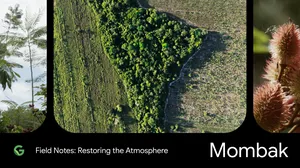Our first-of-its-kind direct air capture deal forges a path to lower costs
Today we’re announcing a new deal to purchase carbon removal credits from direct air capture provider Holocene, at the lowest price on record for this technology: $100 per ton, for delivery by the early 2030s.
We’re committed to doing our part to decarbonize the global economy and reach our goal of net zero emissions across our operations. Carbon removal technologies are key to that goal. Partnering with Holocene to reach this milestone price will be a meaningful step toward advancing the viability of DAC as a tool to fight climate change.
Solving the affordability problem
Direct air capture (DAC) is a promising technology because it uses chemical or physical processes to extract carbon dioxide (CO2) directly from the air, after which it is stored permanently underground or re-used in products. Experts agree we will need to collectively remove billions of tons of CO2 from the atmosphere annually by 2050 to halt climate change, and DAC could be an important part of the solution.
But direct air capture faces a long road to achieving commercial viability and scale. Today, no DAC plant is delivering more than 2,000 tons of carbon removal credits per year. And while the technology is improving, prices remain in the many hundreds of dollars per ton of CO2 removed. For more companies and governments to invest in DAC projects, costs need to fall dramatically.
Our partnership with Holocene aims to address one of the key barriers facing DAC technologies: the hefty price tag. While Holocene’s technology is still in the early stages of development, it has the potential to bring down costs significantly over time.
A few key factors contributed to our deal with Holocene achieving a substantially lower price than typical DAC deals. First, Holocene takes an innovative approach to DAC, combining elements of both liquid and solid-based systems, which has high potential to reduce costs for this difficult physical challenge over the long term. Also, Google will provide financial support up front, while making a long-term commitment to accept credits from Holocene’s lower-cost facilities, scheduled for delivery in the early 2030s. Finally, Holocene’s projects qualify for the U.S. government’s 45Q tax credit on top of Google’s payment, which incentivizes investment in DAC by providing suppliers $180 per ton of carbon removed.
Supporting Holocene’s approach
The foundation of Holocene’s technology is its chemistry. They use amino acids and other organic compounds to continuously capture CO2 from ambient air. Once captured, the CO2 is concentrated and heated to low temperatures to create a pure stream of CO2 that can be transported and permanently stored.
This approach helps Holocene address the high energy and capital costs that make direct air capture so challenging. Low-temperature heat can be sourced from carbon-free or waste heat sources, and Holocene's chemical process uses widely available industrial equipment — giving them a strong path to scaling cleanly and affordably.
Through this deal, Holocene will capture and store 100,000 tons of CO2 by the early 2030s (the equivalent of roughly 20,000 gas-powered vehicles driven in one year) and further accelerate the development of their technology. While this is significantly more CO2 than has been removed and stored by DAC solutions to date, it’s nowhere near the volume of carbon removal that is needed on a planetary scale. But achieving lower cost DAC at a small scale is a first step towards giving the carbon removal market confidence that reaching millions, and even billions, of tons per year could be possible.
A step closer to net zero emissions
The structure of this partnership — providing immediate funding to achieve an ambitious but important price in the medium term — is just one way to support carbon removal as it scales. We hope it will inspire the market to increase its support for solutions that have a strong chance of achieving global impact in the decades ahead, and give those solutions the near-term resources they need to demonstrate their viability and achieve commercial scale.
Beyond this deal, we’ll continue to support catalytic technologies across many carbon removal pathways that will help us — and the world — reach net zero emissions.






